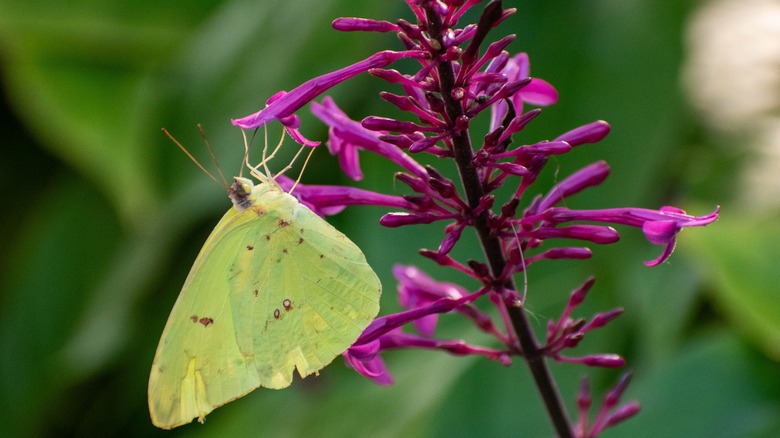Hummingbirds And Butterflies Love This Dramatic Flowering Shrub
When most plants begin to fade, one dramatic flowering shrub surges into action, drawing the attention of winged pollinators with towering spikes of vivid color. This impressive plant fills a critical gap for hummingbirds and butterflies by blooming through fall and winter when nectar-rich flowers are scarce. For gardeners hoping to extend pollinator support into the colder months, purple firespike (Odontonema callistachyum) is an eye-catching solution.
Native to Mexico and Central Americaand best in USDA Hardiness Zones 8b through 11, purple firespike grows fast and tall, often reaching 8 to 10 feet with glossy leaves and lush stems. If you're hoping to attract hummingbirds to your yard with these blooms, it's good to know that tubular blossoms are especially well-suited to hummingbirds. The small, nectar-rich flowers bloom in dense vertical spikes up to 2 feet long, making them easy targets for pollinators in flight. One of the reasons butterflies enjoy them is because they're able to easily locate the bright colors of the plant from a short distance. Butterflies don't see well at a distance and rely on color to find flowers, like many pollinators.
Unlike many late-blooming perennials, firespike doesn't just offer a last-minute feast. It provides nectar from October to July in warm regions, giving both resident and migrating pollinators a valuable seasonal food source. Purple firespike is a great addition if you're looking to avoid common mistakes while you're trying to attract pollinators to your garden. Using different heights and blooming times of plants aids pollinators all year round.
How the purple firespike draws in hummingbirds and butterflies
While many flowering plants go dormant in winter, purple firespike continues to bloom with bold intensity, provided that it has some protection from frost, which can cause some damage to its blooms. Its long, upright spikes are packed with nectar-rich flowers in hues that range from a soft rosy pink to vibrant magenta-pink. The blooms contrast strikingly against dark green foliage and purplish bracts, creating a visual signal that pollinators won't easily miss. This dramatic combination isn't just ornamental, it's functionally designed to attract two of the garden's most captivating visitors: butterflies and hummingbirds.
The secret to attracting hummingbirds is all in their bird's eye view. Hummingbirds are especially attracted to red, pink, and orange flowers, and they see more complex color combinations than humans (such as ultraviolet blended with red or green). The pinky-purple blossoms contain pigments that reflect in the ultraviolet spectrum, making them especially vivid to pollinators, and the flower's shape is perfectly suited to their long bills.
Butterflies have compound eyes made of up to 12,000 lenses and as many as 15 photoreceptors, and many species see a broader range of colors than any other animal. Shades like purple, pink, and red shine brightly in their ultraviolet-rich vision, making purple firespike an ideal plant for them to locate. Firespike's clustered blooms also give them an easy landing zone and consistent nectar source, which is vital when few other plants are in flower.

